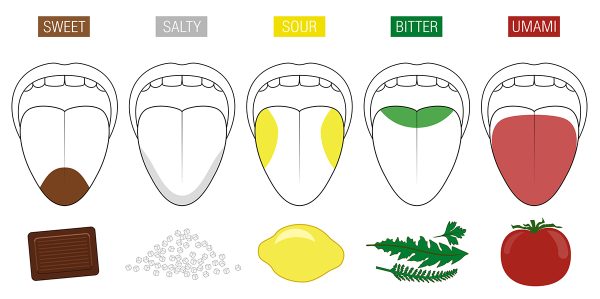Spread out over the tongue are papillae, which contain bud-shaped organs that detect taste. “Taste buds”, as we usually refer to them, are comprised of dozens of taste cells clumped together. The taste cells contain receptors for sweet, salty, sour, bitter and umami substances. From these receptors, information is transmitted to the brain to record the taste of our food.

The least understood but most exciting of these five basic tastes is Umami. Umami is often hard to identify and can be tough to explain, but it is indispensable in creating harmony with other tastes. It gives a sense of smoothness or roundness in the mouth. It acts as a balancing agent, adding savoury notes that are sometimes described as “brothy” or meaty. It also has a lingering, pleasant aftertaste. These effects on flavour are attributed to glutamic acid (Glu), one of the most abundant of all amino acids found in food protein.
In 1908, Kikunae Ikeda, a professor at Tokyo Imperial University, identified the compound in kombu seaweed broth and managed to isolate glutamate to create Monosodium Glutamate, or MSG. Japanese cuisine has long used umami as an essential flavouring ingredient. It is the main component of dashi, the collection of broths that form the base for Miso. It takes very little of this amino salt to highlight the other flavour elements in food and to bring a harmonious balance to the dish.
Kikunae Ikeda
Glutamate is naturally present in foods such as mushrooms, tomatoes (particularly cooked or stewed), peas, onions, asparagus, broccoli and beets. Inosinate (found primarily in meat and fish) and guanylate (derived from mushrooms such as oyster or dried shiitake) are two kinds of nucleotides that also contribute to the umami taste. When inosinate and/or guanylate are combined with a glutamate, it enhances the sensation of umami. Other foods that are full of umami include fish, shellfish (succinic acid, found in large amounts in shellfish, has umami flavours), fish, soy sauce and the ubiquitous North American condiment, Ketchup!
Umami has been found to increase sharply during the aging and fermenting of foods and liquids. During curing, ripening and aging processes, amino acids – including Glu – are converted into “free aminos”, which become more digestible by the body and more prominent on the palate. This is why there are large amounts of umami on that delicious cheese and charcuterie board! Umami is also developed during malolactic conversion, brining and microbial fermentation, imparting savoury notes to olives, sauerkraut, kombucha and kosher dill pickles.
There are several ways umami compounds develop in wine.
Glutamic acid is found in fairly high levels in Vitis Vinifera, the family of grapes most utilized in winemaking. Red wines are more likely to give the taste of umami than whites, as reds are fermented in contact with their skins, where amines are most concentrated. Lighter-bodied reds tend to give off more pronounced umami notes and these savoury elements can amp up the primary and secondary flavours of wines like Pinot Noir, Gamay or Schiava to add complexity. This is why many of these reds make great partners to shellfish and fish.
The later a grape is harvested, the more glutamic acids will form. Sweet late-harvest wines have umami; botryits-affected styles have even more. Botryits is a benign fungus that reduces the water content in grapes, resulting in more glutamic acids, thus more umami. Sublime wines like Sauternes, Tokaji and Germany’s Trockenbeerenauslese are rich with these savoury notes that combine with sweet and sour to create liquid masterpieces. Pair these wines with blue cheeses or well-aged tangy ones for an “umami bomb”!
Various vinification techniques can impact the development of umami compounds in wine. A few studies have suggested that the relative content of glutamic acid increases after malolactic fermentation (MLF), when tart-tasting malic acid, which is naturally present in grape must, is converted into softer, gentler lactic acid. Autolytic conversion, the breakdown of yeast cells dissolving into wine, will create biscuity, bready notes are rife with umami. Sparkling wines spend time on their lees (dead yeast cells) and, in the case of Traditional Method bubblies, yeast that slowly dissolves over time is contained within the bottle itself. Wines that are “sur lie” (aged on their lees) and those that have bâtonnage (regular stirring of the lees that sink to the bottom, to integrate them throughout the wine) will also pick up umami flavours.
The aging process is also thought to enhance umami compounds by breaking down amines. A young, full-bodied Cabernet Sauvignon will mellow, become silkier, smoother, more harmonious and gain savoury notes as it ages, Sangiovese and Tempranillo are two ‘savoury’ grape varieties that gain huge amounts of umami from age.
Despite the many positive effects of umami on flavour, this wonderful taste compound can play havoc with wines, turning many thin, tart and acidic. So be sure to pair foods high in umami with wines that have umami, sweetness and richness, or bubbles.

